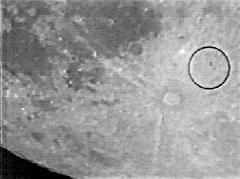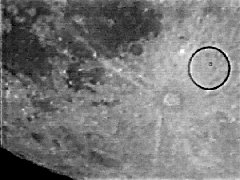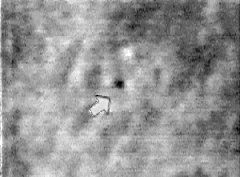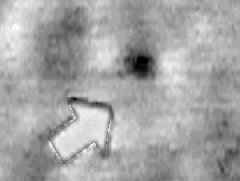The Lunascan Project
presents
A FASTWALKER VIDEOTAPED
IN JAPAN
FW-01-XXXXXX (Date Unknown)
By Francis Ridge, Steve Davis &
Richard Motzer
..

Click
here
for best resolution
A normal frame grab of
the FastWalker heading south near Tycho.
.

Click
here
for better resolution
Same frame grab,
enhanced.
.

Click
here
for better resolution
A blow-up,
approximately 4x.
.

Click
here
for better resolution
A larger blow-up,
approximately 15x.
.
"Sightings" and other TV shows dealing with the paranormal have
shown several videos of strange objects near the moon through a
telescope.One of interest is the Japanese video (date unknown) of
the dark object heading south over the southern highlands near
Tycho. This particular series of video images is pretty good for
several reasons.
1) The object is in focus and is delineated by a bright
surface, nearly a full Moon.
2) The object is moving slow enough to get a good look and is
moving north to south. Most fastwalkers are much briefer. If the
object is an Earth satellite, it has to be in a polar orbit.
However, the object appears to be something much further out.
3) Sightings stated the object was casting a shadow on the
lunar surface. We are not able to confirm this from the videos
we have, however the object appears to be tumbling. This could
be an artifact of light and contrast as the object passes over
brighter/darker areas on the lunar surface.
The most logical explanation for this fastwalker is one we
don't like to think about. Again, we don't know when this video
was taken, but it is not recent, possibly several years old. On
May 19th of this year (1996) an asteroid, 1996JA1, passed by the
Earth at a distance a little further than the Moon (453,000 km).
1996JA1 was the sixth closest Earth-approacher on record, and
was about 500 meters wide, ten times the size of the one that
struck in Arizona and left a mile-wide crater! According
to our sources, a 500 meter asteroid would produce regional, but
not global, devastation.
There are other possibilities for this fastwalker. At times
the shape appears to be rectangular, with the object moving with
its longest axis perpendicular to its flight path, which
would indicate that it could be manmade.
This report is merely a preliminary one. Our first images were
obtained from Jerry Washington, a Project Member in Louisville,
who taped the Sightings show some time ago. I attempted to
ascertain a studio quality video tape from Sightings, but never
got any cooperation. To the rescue came Richard Motzer, of
Scottsdale, Arizona, another Project Member and a consultant who
had a digital direct-feed video via satellite. Richard did a
series of "frame grabs" and produced the four GIFS which we now
have on this web site.
Francis Ridge
Coordinator, The Lunascan Project
I've done some more thinking on the "object/moon" subject. The
final result surprised me.
1. First, I found that the satellite geosynchronous orbit
distance is 21,700 miles. Since this is above the equator, it is
at a location the moon DOES cross.
2. At this altitude, a perfectly geosyncronous object would
stand perfectly still against the sky, and the moon would
actually cross IT. The moon moves roughly 360 degress in 29
days. This amounts to 31 seconds of arc per minute of time. That
rate of movement is quite slow. It is about the same as crossing
the face of Jupiter in 1.5 minutes. This is plenty slow enough
to account for the video we saw.
3. An article in Sky & Telescope, maybe a year ago,
explained that geosynchronous satellites aren't perfectly
geosynchronous, that they actually scribe a path in the sky that
is roughly circular. I think the diameter of this circle was
about 3 degrees. I calculated that the angular velocity within
this circle would be about 23 arc seconds per minute. This is
very slow in itself, but also the moon is moving across the sky
background at roughly 31 arc seconds per minute.
Since this satellite's path is circular, it's angular velocity
could add or subtract with that of the moon's depending on when
the two were in conjunction. The bottom line therefore, is that
the satellite could be seen traveling VERY slowly across the
moon's face. With the above numbers, this could be 8 arc seconds
per minute. I don't have a handbook in front of me, but if you
look up the diameter of a very small crater I think you'd find
it to be about this size (around here, a 1 arc second crater
would be about the smallest crater you could see). So
60 seconds to cross it would be quite slow.
4. The fourth point is what surprised me. I asked myself what
size an object would have to be at 21,700 miles, to appear as
(described). If I chose an apparent angular angular size of 5
arc seconds, which is small but readily visible, I calculate the
object would have to be about 0.5 MILES in diameter! Clearly, no
satellite is that large! An extremely small 1 arc second, about
the limit to resolve, would still be 555 feet in diameter.
So, it looks like a geosynchronous satellite is NOT a likely
candidate for the moon-crossing objects, only because of #4.
I'll do some more calculations if I get orbital velocities of
closer satellites, but it is logical to assume that satellites
closer than 21,700 miles will still be traveling slow enough to
be candidates for the video we saw. The question then would be,
how large do they have to be to appear that large against the
moon.
An alternative analysis would be to say that a reasonable
upper limit for a high altitude satellite size would be 100 feet
(I'm totally ignorant here). At this size, it could be no
farther than about 1950 miles to appear 2 arc seconds in
diameter. I bet that at this distance it would be way too fast
to be a candidate. To appear 10 arc seconds in diameter (about
what the video image looked to me, or even bigger), it would
have to be about 390 miles away! This would be a fast orbit. So,
perhaps no satellite could fit the observation!
Steve Davis,
Project Member
Definitions:
FMOs, Fast-Moving Objects - As described
by a Russian astronomer
Fastwalkers - NORAD term used by The
Lunascan Project
ULOs, Uncorrelated Lunar Objects - To
describe non-moving objects near the Moon, such as "U092196"
Extra-Lunar
Objects Directory
Back to
Home Page



